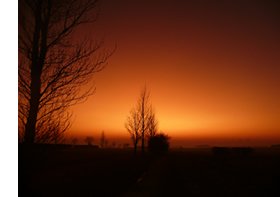
Weather forecasters are not the only people who predict the weather. There are also lots of traditional sayings and proverbs which aim to help ordinary people predict the weather.
The source of most of the sayings is unknown. In the past, when people lived and worked on the land, the weather was very important and they watched for patterns to help them predict the future weather. They then made up rhymes to help them to remember these patterns. Some of these sayings have some truth. Others, which try to predict the weather for the following season from a single event, are unlikely to ever be true. Can you guess which are true or false?
True!
There is a lot of confusion about this saying – although a dusty or polluted atmosphere, more common when the atmospheric pressure is high, can give a very vivid sunset, this saying refers to the passage of a depression across the UK.
Depressions usually travel from west to east, and if one has just passed, then we are unlikely to get another one for a couple of days. So if a depression has just passed, and is to the east of us, the sun setting in the west will illuminate it and give a beautiful red sky. On the other hand if a depression is approaching from the west, and is illuminated by the sun rising in the east, then bad weather is on its way.
True. Ish.
This should probably be adapted to “when swallows fly high, it is currently dry”. Swallows and other birds fly high to chase insects which have been carried up by thermals. If it’s raining, then those same insects will be washed down to lower levels.
Read more at MetMatters
False!
There is no evidence that this is true.
True!
Tall (sailing) ships would lower their sails when bad weather approached. Mackerel sky (altocumulus clouds) and mare’s tails (cirrus clouds) could both be associated with an approaching depression.
False!
St. Swithun’s Day is on 15th July. Although our summers can follow a more or less settled pattern, there has not been a continuous period of 40 days of rainfall since UK records began.
True!
An easterly wind implies polar continental air – which, in winter at least, can be bitterly cold and bring snow to eastern parts of the UK.
False!
In the UK at least, it is never too cold for snow. In places like Antarctica and the middle of large continents, far away from the relatively warm ocean, it may be true. At very cold temperatures, there will be very little evaporation from rivers, lakes etc. and so the air will be very dry and it’s very unlikely to snow.
Sometimes true!
In the summer, clear skies (maybe due to High pressure conditions, or a tropical continental air mass) which allow you to see the mountains can lead to thunderclouds bubbling up through the day and heavy rainfall in the late afternoon.
Mostly false!
Although depressions do tend to cross the UK on a timescale of a few hours, they can move much more slowly. Morning rain could be the last remnant of a depression passing through, but if it’s marking the arrival of a depression, then it’ll still be raining at 11.
False!
Blows it’s horn’ refers to the occurrence of thunderstorms. Thunderstorms in March indicate it is unusually warm for that time of year but this is no indicator of a long term weather trend.
False!
Whether or not there is a storm at the beginning of March (coming in like a Lion), the weather at the end of the month could be stormy or calm (going out like a lamb).
True!
A circle, corona or halo around the sun or moon is an indication of very high cloud (cirrostratus). This can be a sign that a warm front is on its way.
(another version of this saying is “When halo rings Moon or Sun, rain’s approaching on the run” )
True!
A clear night – typically due to High pressure conditions – will let you see the stars well. If there are no clouds to insulate the Earth then more heat will be lost from the surface to space and it will be a cold night.
Try it out!
You can find full instructions here.
